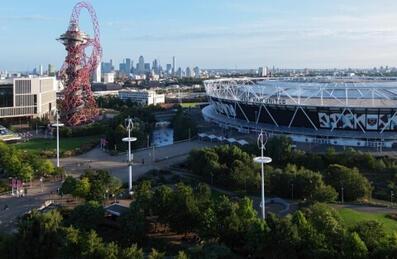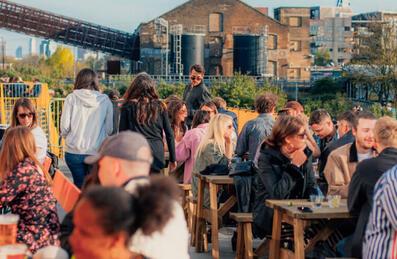
Popular Searches:
Keep up to date
Sign up today for exclusive offers and incredible experiences you won’t want to miss at Queen Elizabeth Olympic Park.
Sign up nowLLDC GREEN INFRASTRUCTURE GUIDE PUBLISHED TO SHARE BEST PRACTICE AND LEARNING
LLDC GREEN INFRASTRUCTURE GUIDE PUBLISHED TO SHARE BEST PRACTICE AND LEARNING
Press Release 21/01/2022
• Green Infrastructure Guide published as industry tool to help urban regeneration projects tackle climate and biodiversity emergencies and social inequality and wellbeing.
• Case studies detail work on Queen Elizabeth Olympic Park and in surrounding areas.
• Contains Green Infrastructure checklist for developers and designers.
The London Legacy Development Corporation has today published a new Green Infrastructure (GI) Guide to support the Mayor of London’s environmental policies addressing the climate emergency, restore and enhance biodiversity and tack social inequalities as well as health and wellbeing.
The Guide has been published in the 10th year since the capital staged the London 2012 Olympic and Paralympic Games which saw the creation of Europe’s largest urban park for more than 150 years.
The document is a best practice guide setting out LLDC’s vision for integrated GI with key principles for stakeholders, development partners, project managers and design teams to consider illustrated by a series of local case studies. It places GI at the heart of urban regeneration rather than treating it as an afterthought to offset the impact of new development.
Rosanna Lawes, Executive Director of Development, said: “The Guide is a vital tool in supporting the Mayor’s policies set out in the London Plan to tackle the climate emergency, improve biodiversity and tackle social inequalities through nature-based solutions.
“The case studies are drawn from our own experience on the Park as well as our partners in the surrounding area in transforming one of the most underdeveloped areas of London into a benchmark 21st century sustainable, urban district.”
Queen Elizabeth Olympic Park is now a thriving urban landscape and a significant piece of GI. It continues to evolve as a sustainable park, providing better flood management, enhancing ecology, increasing contact with nature and strengthening sense of place. The Park has been created to be an integral part of the surrounding city, rather than set apart and protected from the surrounding urban area.
The Guide’s case studies focus on a wide range of examples from the creation of the northern part of the Park as a Sustainable Drainage System (SuDS) to manage flooding risk to the use of green roofs at Here East, the former press and broadcast centre, and creation of active play and amenity spaces for all people throughout the Park.
Chobham Manor case study:
Chobham Manor has been developed as a family friendly neighbourhood in the north of the Park with three shared ‘greens’ and more than 850 houses and apartments set within tree-lined avenues and intimate streets. Provision of open space, biodiversity and play provided an organising principle for the masterplan developed by PRP Architects. The three linked greens provide publicly accessible open space with connections to the adjacent parkland and development and the wider landscape.
GI components in relation to biodiversity include:
• Provision of multifunctional green spaces, biodiverse green roofs and habitats within the public realm to encourage wildlife.
• Tree pits designed to receive surface water run-off wherever possible and colocated within rain gardens/SuDS wherever possible.
• Predominantly native species for habitat creation with the use of cultivars and non-native plants to suit specific growing conditions and to extend the flowering period.
• Creation of urban wetlands and rain gardens to respond to the BAP.
• Creation of a biodiverse streetscape and public realm with approximately 10% of the street area contributing to the BAP.
• Provision of three different biodiverse green roof typologies using native species that are tolerant of extensive roof conditions and mimic pioneer communities.
• Use of mounds of different materials to the biodiverse green roofs as well as shallow ephemeral pools and log piles to create a wider range of habitats and microclimates for wildlife.
• Creation of a green corridor through the centre of the development which in combination with tree lined streets will facilitate movement of wildlife such as bats, birds and insects.
• Extensive fruit tree planting to create a site wide orchard in combination with fruiting hedges.
• Use of green walls to provide vertical habitat in areas of restricted space and additional habitat for birds and insects.
Today, Queen Elizabeth Olympic Park enjoys double the green space made available for the 2012 Games and the Guide’s publication comes at a time when the services and benefits such space provides are more significant than ever because of the pandemic and the climate and biodiversity emergencies.
This is the latest addition to a suite of documents published by LLDC to help shape the design standards for developments on and around the Park including Design Quality Policy; Park Design Guide; Park Management Plan; Queen Elizabeth Olympic Park Valuing Landscape; Lea River Design Manual; Canal Park Design Guide; Inclusive Design Standards; QEOP Valuing Landscape Report; and Biodiversity Action Plan.
Link to Green Infrastructure Guide here.






